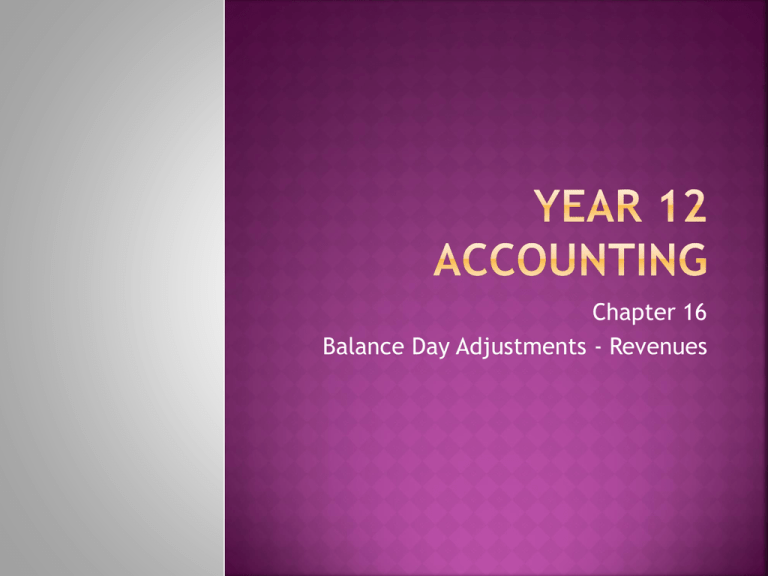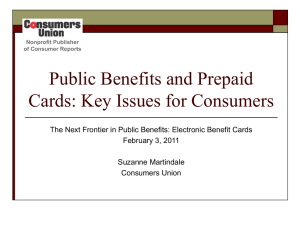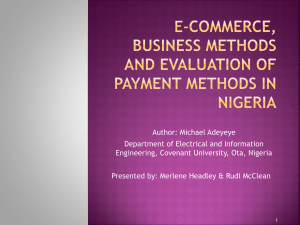Year 12 Accounting Ch 16
advertisement

Chapter 16 Balance Day Adjustments - Revenues Balance day adjustments are made to ensure that revenue accounts show revenues earned and expense accounts show expenses incurred in a particular Reporting period, so an accurate profit can be calculated. So far we have covered balance day adjustments to ensure that expense accounts show the amounts incurred/consumed: stock losses (Chapter 8) prepaid expenses and accrued expenses (Chapter 10) depreciation (Chapter 11). (The only exception is a Stock gain.) In this chapter, we will cover balance day adjustments to ensure that revenue accounts show the amounts earned: prepaid revenues accrued revenues. Revenue is not necessarily cash. The key is that some type of economic benefit has been received (either by assets increasing or liabilities decreasing), and that owner’s equity has increased as a consequence. Do Revenue Question 16.1. Q 3. Although perhaps less frequent than a prepaid expense, it is possible for a firm to receive revenue in advance of supplying the goods. This would be the case for a lay-by, or if a firm accepted subscriptions (for example, to a magazine), or rented out extra space in its warehouse. In cases such as these, the firm would have received the cash, but because it has not supplied any goods (or services) to the customer, it has not earned any revenue. This means the receipt is prepaid revenue, or revenue received in advance. Where revenue is prepaid, the good/service is owed to the customer, so the firm has an obligation to provide them sometime in the future. Thus prepaid revenue is not revenue at all, but rather a current liability – a present obligation that is expected to result in an outflow of economic benefits when the good/service is supplied sometime in the next 12 months. When revenue is received in advance – or prepaid – it must be recorded as a current liability in the journals and ledger accounts. See Journal, General Ledger entries p. 370. Of the $462 cash received from the courier company, $42 is GST that is now owed to the ATO, but the remaining $420 is Prepaid rent revenue – the use of the office space which is owed to the courier company. Note that there is no effect on owner’s equity whatsoever, so the cash received cannot be revenue. Prepaid revenues are recorded as current liabilities because when the cash is received, none of the amount has been earned – it is a present obligation to provide the good or service. However, if by balance day the good/service has been provided to the customer, then the firm will have fulfilled its obligation. That is, the liability has been extinguished, so the revenue has been earned. (This is a very good example of a revenue in the form of a decrease in a liability – Prepaid revenue – rather than the usual increase in assets created by a cash or credit sale.) It is therefore necessary to adjust the ledger accounts so that: the amount earned in the current Reporting period is shown as a revenue the Prepaid revenue account only shows the amount remaining (i.e., unearned, or to be earned in a future Reporting period). See Bag Emporium example. The balance day adjustment to record the prepaid rent revenue earned is shown in the General Journal entry in Figure 16.1. See also General Ledger. As a consequence of the balance day adjustment, a liability becomes a revenue, decreasing liabilities and increasing owner’s equity. Assets do not change at all. The adjusted figure in the revenue account can now be closed to the Profit and Loss Summary account. Remember, all revenue accounts are closed in one General Journal entry, with each revenue account debited to reduce its balance to zero, and one credit to the Profit and Loss Summary account. See Rent Revenue account on p.371. The entries detailed above apply to all prepaid revenues, but Prepaid sales revenue is a particular type of prepaid revenue: it involves the provision of stock. As a result, the recording of Prepaid sales revenue requires the entries in Figure 16.1, with one additional step: stock must also be adjusted. Prepaid sales might occur when a new product is released; customers might pay in advance to ensure they are among the first to have them. See Cash Receipts Journal and General Ledger in text. Our example stated that $900 has been received, but not yet earned. What happens when the goods are supplied? Because the goods have been provided to the customer, the liability has decreased, meaning the revenue has now been earned. The balance day adjustment to record the prepaid sales revenue earned is shown in the General Journal entry in Figure 16.2. Like any adjustment for prepaid revenue earned, this entry credits the Revenue account and debits the Prepaid revenue account $900. However, like any sale, this entry also has a cost price entry: debit Cost of sales, credit Stock Control ($360). (The entry in the stock card would take place when the goods are provided, not when the cash is received.) See General Ledger p. 371. Note: The two entries in the Cost of sales account reflect the cost price of cash sales ($15 000 from the Cash Receipts Journal), and the cost price of the goods which were prepaid and then sold ($360 from the General Journal). Review Questions 16.3. Q’s 2 & 3. Prepaid revenues are received before they are earned, but in some cases revenues will be received after they are earned. For example, interest on a term deposit may have been earned, but is not due to be received until next month. Other items like royalties and commissions may only be received after they have been earned. Because this amount has been earned in the current Reporting period, it must be recognised as revenue. In addition, the amount owing should also be recorded as a current asset, as some time in the future, the cash will be received. The amount owed to us for revenue we have already earned is called accrued revenue. Accrued revenue and debtors are similar in that they are assets. In both cases the revenue is earned before the cash is received, so they represent a resource controlled by the entity (the debt owed to the business), which will bring a future economic benefit in the next 12 months (when the cash is received). However, they are different in a subtle but important way. If the customer has the goods and the invoice, then a credit sale has occurred, and a debtor should be recognised. However, if the revenue relates to a transaction other than sales, and the customer has not been sent the invoice, then accrued revenue has been earned. (As such, accrued revenue will be verified by a memo rather than an invoice). Prior to making any balance day adjustments, the revenue accounts will only show the amounts received. See Kilvington Kites example p. 376. Between 31 January 2015 (when the first six months of interest is received) and 30 June 2015 (when the firm’s reports are prepared), there are five months, and in those five months, the firm has earned five months’ worth of interest revenue. This cash therefore must be added to the revenue account. It is therefore necessary to adjust the ledger accounts so that: the extra amount earned in the current Reporting period is added to the revenue account a current asset account – Accrued revenue – is created to show the amount owing to us (which will be received in the next Reporting period). By balance day, the firm has earned an extra $375 worth of interest revenue that it is yet to receive (Memo 8). The balance day adjustment to record the accrued interest revenue is shown in the General Journal entry in Figure 16.3. See also General Ledger. Note that the amount used in the adjustment ($375) is not the total revenue for the period, it is simply the amount owing. It is added to the amount received to calculate the total revenue earned of $825. As a current asset, the Accrued interest revenue account will be balanced, but the Interest revenue account will be closed to the Profit and Loss Summary account. See p. 378. Remember, for an item to be recognised as revenue, the definition requires an item to be earned; the receipt of cash is not necessary. Sometime in the next Reporting period, the amount owing to us as accrued revenue will be received. Therefore, when the cash is received, some may represent a revenue of the current Reporting period, but at least some of the receipt will relate to the previous Reporting period. In other words, some of the amount received reduces the asset – Accrued revenue. In our example, on 30 June 2015, we created a current asset – Accrued interest revenue – to represent the $375 worth of interest we had earned, but not yet received. That is, we have already counted it as revenue. When the second installment of interest of $450 is received on 31 July 2015 (Rec. 78), we cannot count it as revenue a second time! When the cash is received, we must recognise that of the $450 received: $375 was earned in a previous Reporting period, so it is not revenue in the current period, but rather a reduction in the current asset Accrued interest revenue only the remaining $75 ($450 received – $375 accrued revenue = $75) represents revenue earned in the current Reporting period. The receipt of interest on 31 July 2015 would be recorded in the Cash Receipts Journal as shown in Figure 16.4. The $450 receipt is split; $375 relates to interest which was earned in (and adjusted at the end of) June. This part of the receipt decreases Accrued interest revenue. The remaining $75 is interest earned in the current period. Refer General Ledger p. 380. GST on receipt of accrued revenues In the event that GST applies to the receipt of accrued revenue, it is only the non-GST amount that would be allocated between the revenue and accrued revenue accounts. In our example, it would be recorded in the Cash Receipts Journal as shown on p.380. Review Questions 16.4. All q’s. Read Summary. Read Chapter 17 Where are We Headed?










